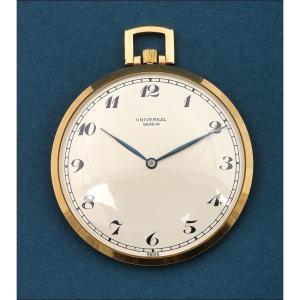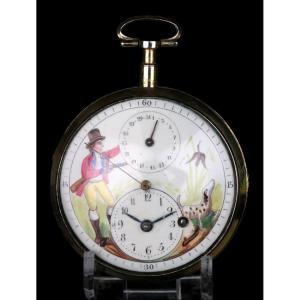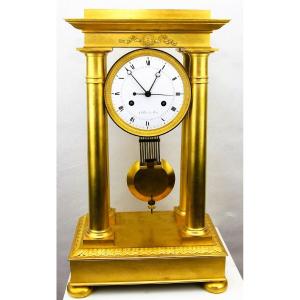The front displays a white porcelain dial with black printed Arabic numerals, featuring two delicate poire-style black hands, a hallmark of 19th-century French design. Below, a smaller sub-dial operates the alarm function, highly prized in these types of clocks. The porcelain shows some faint hairline cracks near the bottom, subtle and superficial, which in no way diminish its charm and authenticity. The mechanism includes a safety system for the alarm train, designed to prevent overwinding, a testament to the careful engineering of the time.
The clock is housed in its original leather case, which includes a viewing window and carrying strap. Though the leather shows signs of aging, the wear on the lid and side straps only confirms its authenticity and period. These types of clocks were first made in the early 19th century by Abraham-Louis Breguet for Napoleon and quickly became essential for officers and travelers, replacing pendulum clocks with more durable mechanisms similar to those found in pocket watches.
Sought after by collectors and ideal for display, this carriage clock is not only a historical artifact but also a solid decorative investment. Its compact silhouette and elegant lines make it a standout piece in both classical and modern interiors.
A striking and historic addition to any fine clock collection, this antique French officer's clock is ready to impress.
Dimensions: 10 x 6.5 x 5.4 cm (3.93 x 2.55 x 2.12 in).
History of Carriage Clocks
Carriage clocks, also known as officer's clocks, originated in the early 19th century as a necessary evolution of the mantel clock. Designed to be portable and shock-resistant, they were popularized by Abraham-Louis Breguet, one of the greatest watchmakers in history, who built the first of these clocks in 1812 for Napoleon Bonaparte. Unlike pendulum clocks, carriage clocks use a sturdy escapement mechanism ideal for travel, often modeled after the pocket watch design.
Throughout the 19th century, these clocks became indispensable accessories for military officers, upper-class merchants, and aristocrats traveling by coach. For this reason, they were often housed in protective leather cases with front windows, just like the one included with this example. Carriage clocks stand as testaments to the refinement and mechanical sophistication of French watchmaking, with makers such as Japy Frères, Drocourt, and Le Roy among the most celebrated.
Today, carriage clocks are highly valued not only for their aesthetics but also for their precise mechanisms and visible movement. Their value has steadily increased among collectors, especially when accompanied by their original protective case. When in good condition and working order, these clocks are becoming increasingly rare and sought-after across Europe, the United States, and Asia.
Owning a 19th-century carriage clock means holding an authentic fragment of European history, an object that blends functionality, elegance, and cultural heritage.


















































 Le Magazine de PROANTIC
Le Magazine de PROANTIC TRÉSORS Magazine
TRÉSORS Magazine Rivista Artiquariato
Rivista Artiquariato